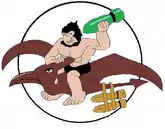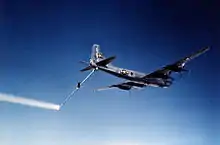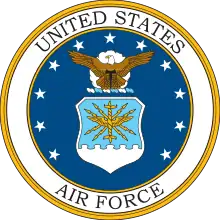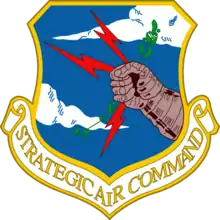407th Air Refueling Squadron
The 407th Air Refueling Squadron is an inactive United States Air Force unit. It was last assigned to the 42nd Bombardment Wing at Loring Air Force Base, Maine, where it was inactivated on 1 October 1990.
| 407th Air Refueling Squadron | |
|---|---|
.jpg.webp) KC-135 Stratotanker of the 42d Bombardment Wing[note 1] | |
| Active | 1942–1946; 1953–1961; 1962–1990 |
| Country | |
| Branch | |
| Role | heavy bomber, air refueling |
| Engagements | European Theater of Operations[1] |
| Decorations | Presidential Unit Citation[1] Air Force Outstanding Unit Award[2] |
| Insignia | |
| 407th Air Refueling Squadron emblem |  |
| 407th Bombardment Squadron emblem (approved 3 June 1943)[1] |  |
The first predecessor of the squadron was activated as the 17th Reconnaissance Squadron in March 1942. It was redesignated the 407th Bombardment Squadron the following month. After participating in the antisubmarine campaign while training, it moved to the United Kingdom, where it participated in the strategic bombing campaign against Germany. It earned a Distinguished Unit Citation for its actions. After V-E Day, it moved to France, where it was inactivated in 1946.
The 407th Air Refueling Squadron was activated in 1953 and supported Strategic Air Command's fighter units and bomber units until inactivating in 1961. It was activated again in 1962. The two units were consolidated in 1985.
History
World War II

Activated as a Boeing B-17 Flying Fortress reconnaissance squadron in early 1942; trained by Third Air Force in the southeastern United States. Performed antisubmarine duty while training in Florida, March–July 1942.
Deployed to the European Theater of Operations, being assigned to VIII Bomber Command in England, one of the first squadrons being assigned to the command. Initially, the squadron initially trained replacement crews for combat at RAF Bovingdon. Upon completion of its training mission, the 407th moved to RAF Alconbury on 6 January 1943 where it and its parent 92nd Bombardment Group underwent reorganization. When they emerged in May 1943, the 92nd and 407th were ready for combat. The group's B-17s, flew their first post-reorganization combat mission on 15 May 1943, and participated in the air offensive over Nazi Germany and Occupied Europe until German capitulation in May 1945.
Reassigned to Air Transport Command in June 1945 as part of Operation Green. Used B-17s as transports, flying demobilized personnel to ATC sites in Morocco and the Azores from France. Aircraft turrets were removed and re-skinned, the bomb racks removed, flooring and seating installed to accommodate 30 passengers. The flight crew was reduced to pilot, co-pilot, navigator, flight engineer and radio operator. In addition the engineer and radio operator would act as stewards, to assist and calm the many first time flyers. Inactivated in February 1946.
Air refueling operations

Activated and redesignated by Strategic Air Command as an air refueling squadron in November 1953. From activation in 1953 until summer of 1957, the 407th Air Refueling Squadron deployed KB-29 aircraft and crews on air refueling missions to many parts of the world, participating in a continuing series of strategic exercises as required by Strategic Air Command. The unit conducted similar operations with the KC-97 aircraft between Jul 1957 and Jul 1961, and with the KC-135 aircraft after Jul 1962, providing air refueling support for various kinds of aircraft from several commands on missions ranging from regional movements to intercontinental flights. The two squadrons were consolidated on 19 September 1985.[3]
The consolidated unit was inactivated in October 1990.
Lineage
- 407th Bombardment Squadron
- Constituted as the 17th Reconnaissance Squadron (Heavy) on 28 January 1942
- Activated on 1 March 1942
- Redesignated 407th Bombardment Squadron (Heavy) on 22 April 1942
- Redesignated 407th Bombardment Squadron, Heavy on 27 September 1944
- Inactivated on 28 February 1946[1]
- Consolidated with the 407th Air Refueling Squadron as the 407th Air Refueling Squadron on 15 September 1985[3]
- 407th Air Refueling Squadron
- Constituted as the 407th Air Refueling Squadron, Strategic Fighter on 13 November 1953
- Activated on 18 December 1953
- Redesignated 407th Air Refueling Squadron, Medium on 15 September 1958
- Discontinued and inactivated on 15 July 1961
- Redesignated 407th Air Refueling Squadron, Heavy and activated, on 26 January 1962 (not organized)
- Organized on 1 April 1962
- Consolidated with the 407th Bombardment Squadron on 15 September 1985
- Inactivated on 1 October 1990.
Assignments
- 92nd Bombardment Group, 1 March 1942 – 28 February 1946[1]
- 407th Strategic Fighter Wing, 18 December 1953
- 4061st Air Refueling Wing, 1 July 1957 – 15 July 1961
- Strategic Air Command, 26 January 1962 (not organized)
- 19th Bombardment Wing, 1 April 1962
- 42nd Bombardment Wing, 2 July 1968 – 1 October 1990
Stations
- Barksdale Field, Louisiana, 1 March 1942
- MacDill Field, Florida, 26 March 1942
- Sarasota Army Air Field, Florida, 18 May – July 1942
- RAF Bovingdon (AAF-112),[4] England, August 1942
- RAF Alconbury (AAF-102),[5] England, January 1943
- RAF Podington (AAF-109),[4] England, 15 September 1943
- Istres Air Base (Y-17),[6] France, June 1945 – 28 February 1946[7]
- Great Falls Air Force Base (later Malmstrom Air Force Base), Montana, 18 December 1953 – 15 July 1961[8]
- Homestead Air Force Base, Florida, 1 April 1962[9]
- Loring Air Force Base, Maine, 2 July 1968[10] – 1 October 1990
Aircraft
- Boeing B-17 Flying Fortress, 1942–1946[1]
- Boeing KB-29 Superfortress, 1953–1957
- Boeing KC-97 Stratotanker, 1957–1961
- Boeing KC-135 Stratotanker, 1962–1990
References
Notes
- Explanatory notes
- Aircraft is Boeing KC-135A Stratotanker, serial number 61-325. Taken at RAF Mildenhall on 7 September 1986.
- Aircraft is Boeing B-17F-80-BO, serial 42-29996 "Flag Ship" at Alconbury. This aircraft was lost on 16 November 1943, commanded by 2Lt Joseph F Thornton, of the crew; 1 evaded capture, 9 became POWs. Missing Aircrew Report 1384.
- Citations
- Maurer, Combat Squadrons, p. 498
- "Air Force Personnel Services: Unit Awards". Air Force Personnel Center. Retrieved 14 September 2020. (search)
- Department of the Air Force/MPM Letter 662q, 19 September 1985, Subject: Reconstitution, Redesignation, and Consolidation of Selected Air Force Tactical Squadrons
- Station number in Anderson, p. 20.
- Station number in Anderson, p. 19.
- station number in Johnson, p. 27.
- Station information through 1946 in Maurer, Combat Squadrons, p. 498, except as noted.
- Mueller, p. 361
- Mueller, p. 256
- Mueller, p. 329
Bibliography
- Anderson, Capt. Barry (1985). Army Air Forces Stations: A Guide to the Stations Where U.S. Army Air Forces Personnel Served in the United Kingdom During World War II (PDF). Maxwell AFB, AL: Research Division, USAF Historical Research Center. Archived from the original (PDF) on 23 January 2016. Retrieved 28 June 2017.
![]() This article incorporates public domain material from the Air Force Historical Research Agency website http://www.afhra.af.mil/.
This article incorporates public domain material from the Air Force Historical Research Agency website http://www.afhra.af.mil/.
- Johnson, 1st Lt. David C. (1988). U.S. Army Air Forces Continental Airfields (ETO) D-Day to V-E Day (PDF). Maxwell AFB, AL: Research Division, USAF Historical Research Center. Archived from the original (PDF) on 29 September 2015. Retrieved 26 June 2017.
- Maurer, Maurer, ed. (1983) [1961]. Air Force Combat Units of World War II (PDF) (reprint ed.). Washington, DC: Office of Air Force History. ISBN 0-912799-02-1. LCCN 61060979. Retrieved 17 December 2016.
- Maurer, Maurer, ed. (1982) [1969]. Combat Squadrons of the Air Force, World War II (PDF) (reprint ed.). Washington, DC: Office of Air Force History. ISBN 0-405-12194-6. LCCN 70605402. OCLC 72556.
- Mueller, Robert (1989). Air Force Bases, Vol. I, Active Air Force Bases Within the United States of America on 17 September 1982 (PDF). Washington, DC: Office of Air Force History. ISBN 0-912799-53-6. Retrieved 17 December 2016.
- Ravenstein, Charles A. (1984). Air Force Combat Wings, Lineage & Honors Histories 1947-1977 (PDF). Washington, DC: Office of Air Force History. ISBN 0-912799-12-9. Retrieved 17 December 2016.
- Smith, Richard K. (1998). Seventy-Five Years of Inflight Refueling: Highlights, 1923-1998 (PDF). Air Force History and Museums Program. Washington, DC: Government Printing Office. Retrieved 17 December 2016.
- History of the 407th Air Refueling Squadron

